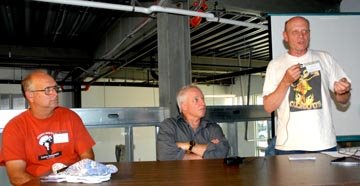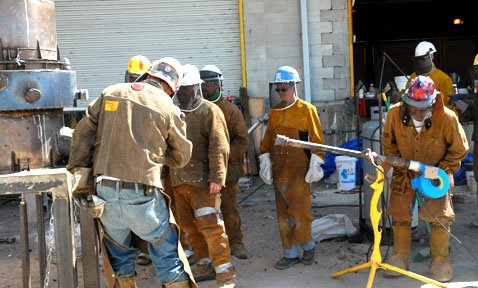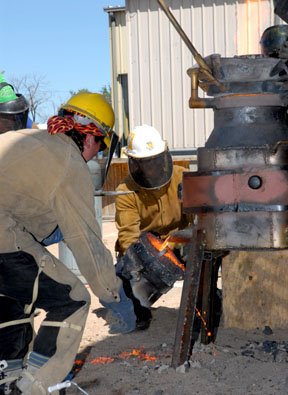Onward from Denver
The Western Cast Iron Art Conference was a good meeting, although I missed some of the most interesting parts getting there late. The metallurgy panel that Elliot Brown, Donnie, & I did seemed to be well received. Elliot is a “real” metallurgist and gave a technical presentation, Donnie described how he approaches the same thing from a “seat of the pants” viewpoint, and, as moderator, I just took notes and summed up what seemed to be most important.
The “Iron Tribe” exhibition opening featured a celebration of the life of Charlie Hook by his widow Deborah LaGrasse. I knew Charles for more years than either of us wanted to admit and I’ll miss his participation in things iron.
The exhibit itself was a remarkable survey of works from old & new guard, foreign & domestic. Some were just the molds that were to be cast the next day during the production pours. They were just as interesting as sculptures in sand as the eventual castings. Great presentation of the work, in a nice space. Kudos to David Lobdell.
The “performance casting” night went off without any apparent hitches. Bowling will never seem the same after watching freshly cast, glowing cast iron balls run down the ramp towards a set of ceramic shell bowling pins.
The production pour day seemed to go well too. We didn’t participate because our furnace didn’t work, but the furnaces that did run functioned well. Furnaces from the University of Minnesota, University of Montana, and University of Colorado, Denver were the stars of the day. The fact that the M & M cupolas were student built, bodes well for the future. The Montana furnace cast the largest piece from the workshops and an “Iron Trail to the Arctic” plaque, we left the plaque with the Denver host crew.
While the pouring action was happening, students from Lamar University rammed-up the refractory into the trashcan that will be our Alaska furnace. When it was done we lit a fire in it and went to my sister’s home for drinks and dinner. That fact that my sister makes excellent wine made drinks somewhat mandatory, the fact that Tom, her husband, makes whisky from any unclaimed alcohol made it dangerous. They were grand & generous hosts.
The “Trail” continued Sunday, getting as far as Casper Wyoming. Monday started fast, but slowed down with sight-seeing. The interstate goes right by the scene of G.A. Custer’s defeat at Little Big Horn, we had to stop. As a battlefield, it wouldn’t be my choice, there was no cover to fight from. Custer made mistakes and his Indian opponents didn’t. Custer lost. It was very strange to stand at the highest point of the battle scene and try to imagine the actions that took place so long ago. The mayhem, noise, smells had to be totally disorienting to the 7th Cavalry; modern archeology has exposed a lot of the causes of the defeat, finding firing patterns from both sides with forensic techniques.
As I say it was somewhat surreal, but one of the most surreal facets was that, as I was walking back down from the scene of the conflict, I was met by a bus-load of Japanese tourists climbing up the hill. I can’t imagine what they took away from the experience.
So for tonight, from lovely downtown Billings, Montana, peace…
Butch
Note: any photographs will be by Forrest Goodhue, official photographer for all things Iron.











